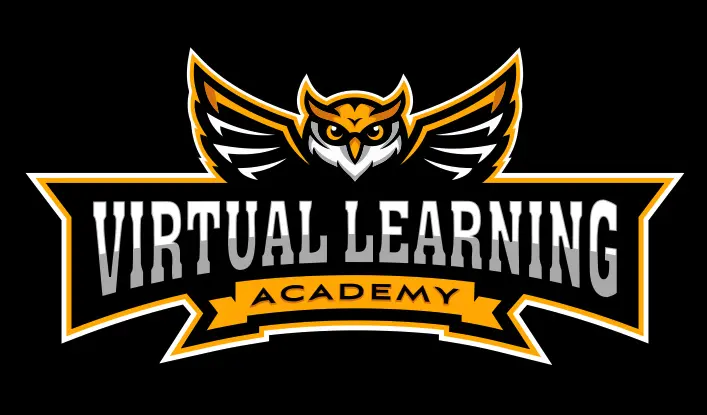Client: Virtual Learning Academy (VLA)
Location: Exeter, New Hampshire
Project: Digital-First Educational Brand Identity

Virtual Learning Academy (VLA) provides a fully online educational experience for K-12 students throughout New Hampshire, offering flexible, personalized learning pathways outside traditional classroom environments. As an established online charter school under New Hampshire’s School Administrative Unit 16, VLA needed a visual identity that would effectively communicate their digital-native educational model while building credibility and recognition in an increasingly competitive virtual learning landscape.
Despite their progressive educational approach, VLA’s visual identity failed to reflect their technological sophistication or create meaningful differentiation in the online education sector. The academy approached our agency to develop a comprehensive brand identity system optimized for digital environments while maintaining the institutional credibility expected of an accredited educational organization.
Through collaboration with VLA leadership, we established several focused objectives:
- Create a digital-first identity system that functions primarily in online environments
- Develop branding that communicates educational innovation and technological fluency
- Design a flexible framework adaptable across diverse digital platforms and applications
- Establish stronger differentiation within the online education marketplace
- Build a system that bridges digital learning with recognized educational credentials
Strategic Approach
Our research revealed key insights about effective online education branding:
- Successful virtual school identities balance:
- Digital innovation with educational tradition
- Technological sophistication with human connection
- Learning flexibility with academic structure
- Virtual presence with institutional credibility
- Online educational brands require distinctive considerations including:
- Primary existence in digital rather than physical environments
- Adaptation across diverse screen sizes and interface contexts
- Consistent functioning within various learning management systems
- Effective reproduction across both digital and limited physical touchpoints
- Virtual learning environments necessitate visual systems that:
- Create immediate recognition within crowded digital interfaces
- Function effectively at both icon size and full presentation
- Maintain visual integrity across varied digital backgrounds
- Support personalization while maintaining consistent brand presence
These insights guided our development of a digital-optimized identity system that would position VLA as a sophisticated online learning provider while maintaining appropriate educational credibility.
Design Development
Core Digital Identity
The Virtual Learning Academy identity features several strategic components:
- Screen-Optimized Mark: A distinctive visual element designed specifically for digital environments, with careful consideration of pixel rendering, color reproduction across devices, and recognition at various sizes.
- Digital-Native Color System: A color palette optimized for screen viewing that maintains consistency across devices while providing sufficient contrast for accessibility compliance.
- Interface-Ready Typography: A carefully selected type system featuring screen-optimized fonts that maintain readability across diverse digital contexts while projecting contemporary educational sophistication.
- Responsive Design Elements: Supporting graphics and visual components designed to adapt fluidly across different screen sizes and orientations, maintaining consistent brand presentation from smartphones to desktop environments.
- Motion Integration: Subtle animation principles incorporated into static elements, allowing for consistent translation between static and motion-based applications.
Online Education Applications
The identity extends to support VLA’s specialized digital learning context:
Learning Platform Integration
- Learning management system interfaces
- Student portal environments
- Assignment submission systems
- Digital progress reporting
Communication Applications
- Virtual classroom environments
- Email and messaging templates
- Video conferencing identifiers
- Social media and digital marketing
Limited Physical Extensions
- Essential printed credentials
- Required administrative documentation
- Graduate recognition materials
- Promotional items and community presence
Virtual Academy Considerations
Several specialized factors influenced our design decisions:
Digital Accessibility
All visual elements meet WCAG accessibility standards for digital environments, ensuring the brand functions effectively for all users regardless of ability or assistive technology needs.
Multi-Platform Functionality
The system maintains consistent presentation across various operating systems, browsers, and devices—acknowledging the diverse ways students access online education.
User Experience Integration
Identity elements work harmoniously with interface design principles, supporting rather than competing with the functional aspects of digital learning environments.
Trust Signaling
Visual components balance digital innovation with appropriate educational gravitas, addressing parent concerns about online education credibility through thoughtful design choices.
The resulting identity system provides Virtual Learning Academy with a sophisticated digital presence that effectively communicates their innovative online educational model while creating recognition and credibility in the virtual learning landscape.
Read our Ultimate School Branding Guide.
Everything you need to know to create a kick-ass school brand that creates results.
